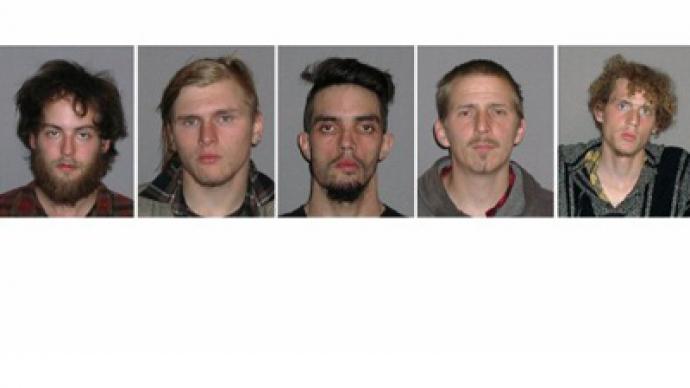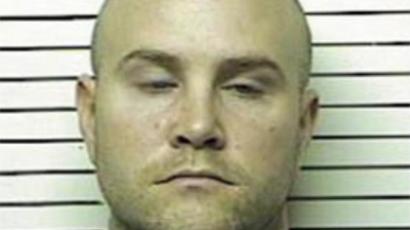Operation: Entrapment - Cleveland bomb "plot" masterminded by FBI agents

Federal agents announced on Tuesday that they successfully thwarted plans to blow up a bridge in Cleveland, Ohio. What was left out of most reports, however, was that the FBI was instrumental in plotting the potential attack.
As is the case with most terrorist attacks revealed by the FBI, from the very beginning of the alleged crime until this week’s arrests, the charges introduced by federal agents were orchestrated by undercover agent provocateurs.Five men were arrested in the Cleveland area on Monday for charges of conspiracy and the use of explosive materials. According to the criminal complaint released this week by the US District Court for the Northern District of Ohio, prosecutors link Brandon Baxter, 20; Anthony Hayne, 35; and Douglas Wright, 26, to an anti-government plot that involved bringing a large bridge in the region crashing down with the aid of at least two accomplices. "The individuals charged in this plot were intent on using violence to express their ideological views,” explains Special Agent Stephen D. Anthony of the Cleveland Division of the FBI this week. Taking a closer look at the federal complaint against the five men reveals that although the suspects are believed to have expressed anti-government sentiments and disdain for major financial corporations, the impetus in the would-be bombing was the urging of undercover agents that had infiltrated a group of friends and encouraged them to consider acts of terrorism. Although the incident is still developing, federal authorities have submitted statements and recordings stemming from conversations their contacts had with the alleged terrorists, and unsurprisingly the mainstream media is largely ignoring one key problem with the federal probe: the FBI provoked members of an Occupy Wall Street off-shoot to embrace terrorist-like crimes despite voicing from the start that they were opposed to such.The criminal complaint considers the entire operation to have started from an Occupy Wall Street style protest in Cleveland on October 21, 2011. There the FBI dispatched an unnamed confidential human source — referred to as CHS in the criminal complaint — who had been recruited by the agency to work undercover earlier in the year. The FBI describes the CHS as a felon that had been convicted of at least six charges dating back to the 1990s, including cocaine possession and robbery, yet entrusted the source to attend the OWS meeting in order to investigate reports “of potential criminal activity and threats involving anarchists who would be attending” the protest. Once there, the CHS singled out participants who “acted differently than the other people in attendance,” including the aforementioned accused, Douglas Wright. The CHS then forged a relationship with Wright that lasted until this week.Although it seems straight out of a spy novel, it is commonplace within domestic intelligence agencies. An exposé put together last year by Mother Jones and the Investigative Reporting Program at the University of California-Berkley reveals that the FBI currently has as many as 15,000 undercover agents working within their ranks, with some making as much as $100,000 per assignment from Uncle Sam. What’s more is that the FBI regularly dabbles in entrapment in order to encourage and create crime. The same study shows that of around 500 prosecutions in recent years relating to terrorism charges, the FBI used informants for about half of them. Of 158 of prosecutions that ended in convictions, around one-third acted on plots perpetrated by federal agent provocateurs. According to the criminal complaint, Wright and fellow self-described anarchists had been considering options “in order to send a message to corporations and the United States government,” that had at that point consisted of nothing more than knocking the signs off of banks in downtown Cleveland while concurrently detonating smoke grenades to distract law enforcement. Wright is also said to have suggested the group use items such as stink bombs or paint guns, objects available to children, in order to make a statement. When Wright told the CHS that C4 explosives may be out of the question due to the cost, the undercover agent asked how much money it would take. “I’m not sure, I haven’t really read too much into it,” said Wright in reference to instructions he found in a digital copy of the Anarchists Cookbook. “Well, you gotta get with me,” pleaded the CHS. “If we gonna be trying to do something in a month you need to get with me as soon as possible on how much money we gonna need.”That conversation is reported by the FBI to have occurred on March 22. In another encounter on March 28, both Wright and his cohort Brandon Baxter said that they did not want people to think that they are terrorists. On that same day, along with the undercover informant, the group drove over Valley View Bridge and the conversation turned to bringing a similar structure to the ground.“I could show you,” said the informant, who then urged the group to exit the highway and investigate the bridge. The CHS then asked if they would be interested in purchasing blocks of C4 explosives, suggested to them that they need two, and then offered to put them in touch with another FBI agent, this time a 15-year veteran with a decade off the radar. On a March 28 meeting, Wright refused an offer to purchase “heavy stuff” from the agent. Later in the week, the officer asked them to consider purchasing a larger quantity of C4 at a discounted rate. Days later, the CHS insisted that Wright and Baxter act quick because they were “on the hook” for the explosives. In the weeks leading up to the alleged attack, the FBI says that Baxter at one point said that the group had never agreed to blow up a bridge and that he personally feared that, if caught committing a large-scale crime, the anarchists would be sent to the military prison at Guantanamo Bay. The CHS attempted to ease those concerns by offering the group decoy license plates and provided them with ways to establish an alibi should they follow through. On Tuesday this week, law enforcement announced that five men had been arrested in conjunction with the terrorist plot and now both Baxter and Wright face hefty sentences if convicted. For engaging in a conspiracy to commit offense they can each suffer up to five years in prison and a fine of a quarter of a million dollars; for the use of explosive materials, they could spend another decade behind bars. And for engaging in hostilities against the United States while working for a terrorist organization? Well, it’s a long-shot, but if the government really wants to invoke the National Defense Authorization Act, or NDAA, then Wright and Baxter could end up at Gitmo until the end of time. "The problem with the cases we're talking about is that defendants would not have done anything if not kicked in the ass by government agents," attorney Martin Stolar tells Mother Jones. Although Stolar is not working with this case currently, the lawyer previously represented the suspect the linked to a New York City bombing plot that was set-up by FBI agents. "They're creating crimes to solve crimes so they can claim a victory in the war on terror." For their part, the FBI says this method is a plan for "preemption," "prevention" and "disruption."There is a happy ending for someone, at least: The convicted robber and hard-drug user turned FBI informant will probably just be sent to infiltrate more OWS protests, though.













